中医英语翻译
- 格式:doc
- 大小:38.50 KB
- 文档页数:12
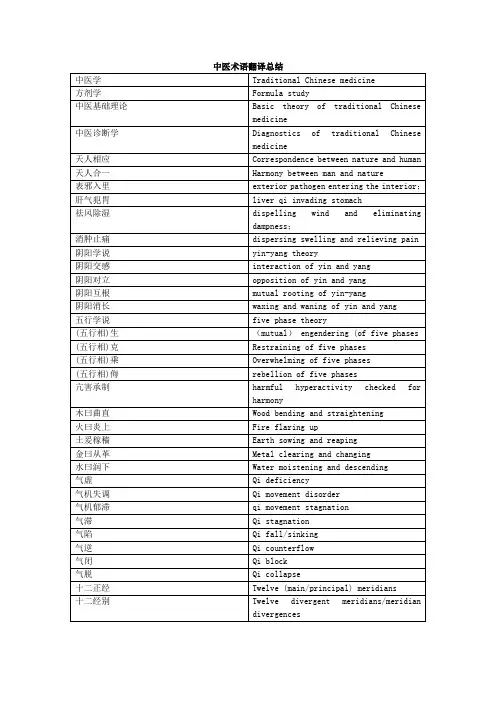
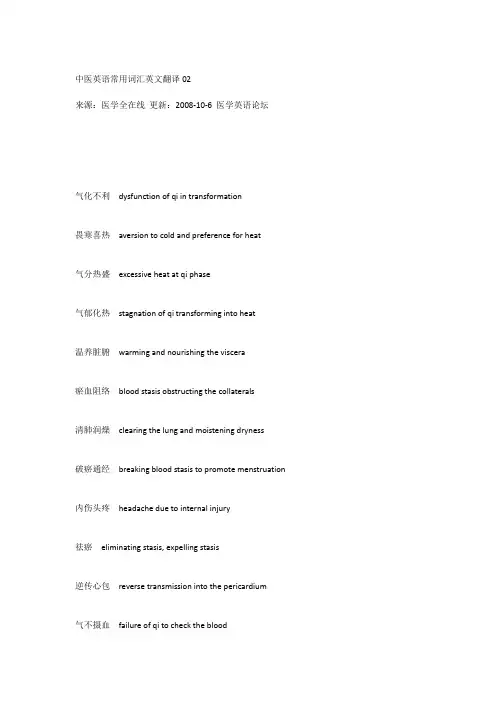
中医英语常用词汇英文翻译02来源:医学全在线更新:2008-10-6 医学英语论坛气化不利dysfunction of qi in transformation畏寒喜热aversion to cold and preference for heat气分热盛excessive heat at qi phase气郁化热stagnation of qi transforming into heat温养脏腑warming and nourishing the viscera瘀血阻络blood stasis obstructing the collaterals清肺润燥clearing the lung and moistening dryness破瘀通经breaking blood stasis to promote menstruation 内伤头疼headache due to internal injury祛瘀eliminating stasis, expelling stasis逆传心包reverse transmission into the pericardium气不摄血failure of qi to check the blood宁心安神calming the heart and tranquilizing the mind血液循行circulation of the blood惊悸不安palpitation due to fright气的运动形式the moving styles of qi血液生成不足insufficient production of the blood平肝止血soothing the liver to stop bleeding血液亏虚deficiency of the blood离经之血abnormal flow of the blood津液的形状、功能与分布form, function, and distribution of the body fluid 气血生化之源source for the production and transformation of qi and blood 脉细无力thin and weak pulse肌肤干燥dry skin肌肤甲错squamous and dry skin血脉调和流畅smooth and normal flow of the blood脏腑火热炽盛exuberant fire and heat in the viscera机体正常水液normal fluid inside the body热迫血分heat invading the blood phase气滞津停retention of fluid due to stagnation of qi寒凝气滞stagnation of cold and qi身倦乏力lassitude气滞血瘀qi stagnation and blood stasis伤津脱液consumption and loss of the body fluid津液的营养和滋润作用the nourishing and moistening functions of the body fluid 津液的生成、输布和排泄production, distribution, and excretion of the body fluid 腹痛拒按unpalpable abdominal pain脾的“散精”功能the function of the spleen to “dissipate essence”津液不足insufficiency of the body fluid水液停聚retention of water奇经八脉eight extraordinary vessels, eight extraordinary meridians胃的“游溢精气”the function of the stomach to “distribute essence”津液生化匮乏scanty production of the body fluid津液的代谢平衡the metabolic balance of the body fluid热盛耗伤津液consumption of the body fluid due to excessive heat风为百病之长wind is the leading factor in causing various diseases水液代谢障碍disturbance of water metabolism气随津脱exhaustion of qi due to loss of body fluid水湿困脾dampness encumbering the spleen濡养肌肤moistening and nourishing the skin湿邪内盛exuberance of interior dampness经脉之海sea of meridians脾虚水肿edema due to spleen deficiency滋养脏腑moistening and nourishing the viscera运行全身气血transporting qi and blood in the whole body十二经别twelve branches of meridians联络脏腑肢节connecting with viscera, limbs and joints经别divergent meridians循行路线running route经气meridian qi十二正经twelve regular meridians十二皮部twelve skin areas, twelve skin regions/divisions 经隧阻滞blockage of meridians十二经筋twelve meridian tendons经穴meridian acupoints, Jing-River acupoint饮食劳倦improper diet and overstrain经络辨证syndrome differentiation according to meridians 风寒感冒common cold due to wind-cold经络感传meridian conduction, channel transmission湿热泄泻diarrhea due to damp-heat经络现象meridian phenomena内生五邪five endogenous pathogenic factors经络阻滞blockage of meridians风邪外袭pathogenic wind attacking the superficies舒筋活络relaxing tendons and activating collaterals游走性关节疼痛migratory arthralgias刺血疗法blood-pricking therapy阳气衰退decline of yang-qi外感六淫attacked by six climate pathogenic factors六淫six climatic evils感受寒邪attacked by pathogenic cold经闭发肿amenorrhea with edema虚实夹杂deficiency complicated with excess, asthenia complicated with sthenia 邪正盛衰predominance or decline of pathogenic factors and healthy qi寒性凝滞cold tending to stagnate by nature病症的虚实变化asthenia and sthenia changes of disease腠理闭塞blockage of muscular interstices机体的抗病能力body resistance经脉拘急收引contraction of tendons五心烦热feverish sensation over the five centers湿邪困脾pathogenic dampness encumbering the spleen五心five centers (palms, soles and chest)疾病的发生、发展与变化occurrence, development and changes of disease 生津安神promoting the production of body fluid and tranquilizing the mind 体质强弱conditions of constitution蓄血发黄jaundice due to blood accumulation气血功能紊乱dysfunction of qi and blood脾阳不振inactivation of spleen yang阴阳偏盛大relative predominance of yin and yang阴虚生内热yin deficiency generating interior heat五志过极extreme changes of emotions热极生风extreme heat producing wind精气夺则虚depletion of essence causing deficiency七情内伤internal injury due to emotional disorder阴阳互损mutual consumption of yin and yang饮食不节improper diet真热假寒true heat and false cold暴饮暴食craputence气机郁滞不畅stagnation of qi activity神昏谵语coma and delirium津液代谢失常disorder of fluid metabolism四诊合参combined use of the four diagnostic methods 寒热往来alternate attacks of chill and fever精神活动mental activities津伤化燥consumption of fluid transforming into dryness 面部表情facial expressions风火胁痛hypochondriac pain due to wind-fire精充气足sufficient essence and abundant qi口眼歪斜wry mouth with distorted eyes, facial distortion 预后良好favorable prognosis湿浊内生endogenous turbid dampness表情淡漠apathetic facial expressions虚火上炎flaming of asthenia-fire精神不振dispiritedness邪气内陷internal invasion of pathogenic factors神志不清unconsciousness大肠热结retention of heat in the large intestine轻宣润燥dispersing lung qi and moistening dryness心脉瘀阻blood stasis in the heart vessels四肢抽搐convulsion of the limbs镜面舌mirror-like tongue脏腑辨证syndrome differentiation of viscera饥不欲食hunger without desire for food病位与病性location and nature of disease脉有胃气pulse with stomach qi表里同病disease involving both the exterior and interior清里泄热clearing away heat in the interior风热眩晕vertigo due to wind-heat寒证化热cold syndrome transforming into heat syndrome寒热错杂simultaneous occurrence of cold and heat舌淡苔白而润滑light-colored tongue with white and slippery coating表邪入里invasion of the exterior pathogenic factors into the interior祛风解痉expelling wind to relieve convulsion外感胃脘痛stomachache due to exogenous pathogenic factors医.学全.在.线网站恶寒与恶热aversion to cold and aversion to heat潮热盗汗tidal fever and night sweating口干唇裂dry mouth with cracked lips高热谵妄high fever with delirium脉数无力rapid and weak pulse和血止痛regulating blood to alleviate pain寒邪郁而化热stagnation of pathogenic cold changing into heat寒因寒用treating pseudo-cold syndrome with herbs of cold nature未病先防preventing measures taken before the occurrence of disease 热因热用treating pseudo-heat syndrome with herbs of heat nature 补气健脾invigorating qi and strengthening the spleen塞因塞用treating obstructive syndrome with tonifying therapy补血养心enriching blood to nourish the heart发汗解表relieving exterior syndrome by diaphoresis水气凌心water attacking the heart风热乳蛾tonsillitis due to wind-heat心悸多梦palpitation and dreaminess痰饮咳嗽cough due to fluid retention血为气母the blood serving as the mother of qi实热蕴结accumulation of sthenia-heat调摄精神regulating mental states舒肝和胃soothing the liver and harmonizing the stomach 血脉流畅smooth circulation of blood清热泻火clearing away heat and reducing fire关节通利smooth movement of joints疏风泄热dispelling wind and reducing heat气机调畅free activity of qi行气消瘀activating qi to resolve stagnation益寿延年promoting longevity养血润肠nourishing the blood and moistening the intestine治病求本treatment of disease must concentrate on the principle cause of disease因时、因地、因人制宜applying proper therapeutic measure in line with season, local conditions and individuality急则治其标relieving the secondary symptoms first in treating acute disease缓则治其本relieving the primary symptoms in treating chronic disease通腑泄热purging fu-organs to eliminate heat燥湿化痰drying dampness and resolving phlegm标本兼治treatment focusing on relieving both the secondary and primary symptoms正虚邪实asthenia of healthy qi and sthenia of pathogenic factors痰湿壅肺accumulation of phlegm-dampness in the lung血枯经闭amenorrhea due to blood exhaustion祛虫消积removing parasites to eliminate accumulation该文章转载自医学全在线:/yingyu/2008/23229.shtml。
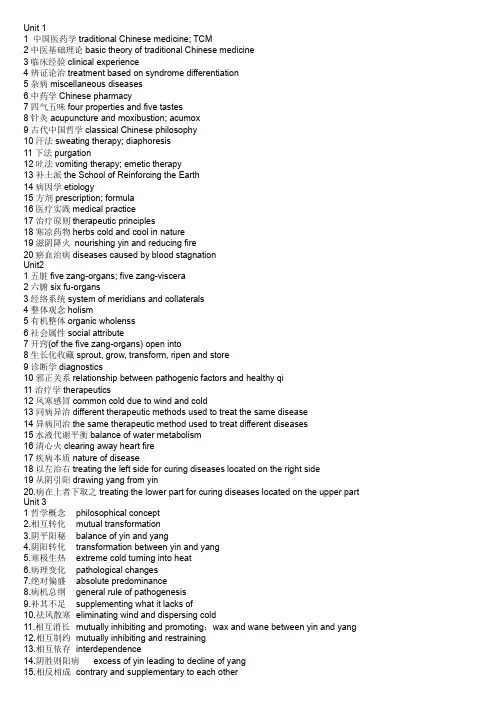
Unit 11 中国医药学traditional Chinese medicine; TCM2中医基础理论basic theory of traditional Chinese medicine3临床经验clinical experience4辨证论治treatment based on syndrome differentiation5杂病miscellaneous diseases6中药学Chinese pharmacy7四气五味four properties and five tastes8针灸acupuncture and moxibustion; acumox9古代中国哲学classical Chinese philosophy10汗法sweating therapy; diaphoresis11下法purgation12吐法vomiting therapy; emetic therapy13补土派the School of Reinforcing the Earth14病因学etiology15方剂prescription; formula16医疗实践medical practice17治疗原则therapeutic principles18寒凉药物herbs cold and cool in nature19滋阴降火nourishing yin and reducing fire20瘀血治病diseases caused by blood stagnationUnit21五脏five zang-organs; five zang-viscera2六腑six fu-organs3经络系统system of meridians and collaterals4整体观念holism5有机整体organic wholenss6社会属性social attribute7开窍(of the five zang-organs) open into8生长化收藏sprout, grow, transform, ripen and store9诊断学diagnostics10邪正关系relationship between pathogenic factors and healthy qi11治疗学therapeutics12风寒感冒common cold due to wind and cold13同病异治different therapeutic methods used to treat the same disease14异病同治the same therapeutic method used to treat different diseases15水液代谢平衡balance of water metabolism16清心火clearing away heart fire17疾病本质nature of disease18以左治右treating the left side for curing diseases located on the right side19从阴引阳drawing yang from yin20.病在上者下取之treating the lower part for curing diseases located on the upper part Unit 31哲学概念philosophical concept2.相互转化mutual transformation3.阴平阳秘balance of yin and yang4.阴阳转化transformation between yin and yang5.寒极生热extreme cold turning into heat6.病理变化pathological changes7.绝对偏盛absolute predominance8.病机总纲general rule of pathogenesis9.补其不足supplementing what it lacks of10.祛风散寒eliminating wind and dispersing cold11.相互消长mutually inhibiting and promoting;wax and wane between yin and yang12.相互制约mutually inhibiting and restraining叮叮小文库16.有机整体organic whole17.阳损及阴impairment of yang involving yin18.阴阳两虚deficiency of both yin and yang19.虚寒证deficiency cold syndrome20.潜阳熄风suppressing yang and eliminating windUnit41 the theory of five elements 五行学说2 free development 条达舒畅3 to be generated and to generate生我,我生4 restraint in generation 生中有制5 over restriction and counter-restriction相乘相侮6 Wood over restricts earth because it is deficient.土虚木乘7 promotion, restriction, inhibition and transformation 生克制化8 disorder of a mother-organ involving its child-organ 母病及子9 insufficiency of essence and blood in the liver and kidney 肝肾精血不足10 blood deficiency in the heart and liver 心肝血虚11 exuberant fire in the heart心火亢盛12 insufficiency of liver yin 肝阴不足13 declination of kidney yang肾阳式微14 weakness of the spleen and stomach 脾胃虚弱15 soothing the liver and harmonizing the stomach 平肝和胃16 between water and fire水火不济Unit51 藏象学说doctrine of visceral manifestations2 五脏六腑five zang-organs and six fu-organs3 奇恒之腑extraordinary fu-organs4 水谷精微nutrients of water and food5 传化水谷transmitting and transforming water and food6 贮藏精气storing essence7 表里关系internal and external relationship8 治疗效应therapeutic effects9 临床实践clinical practice10 藏而不泻storage without discharge11泻而不藏discharge without storage12形体诸窍physical build and various orifices13开窍(of five zang-organs) open into14精神情志spirit and emotions15心藏神the heart storing spirit16肺藏魄the lung storing corporeal soul17肝藏魂the liver storing ethereal soul18脾藏意the spleen storing consciousness19肾藏志the kidney storing will20其华在面the luster manifesting upon the faceUnit61 心主血脉the heart governing blood and vessels2 心气充沛sufficiency of heart qi3 面色红润rosy complexion4 血液充盈sufficiency of blood5 脉道不利unsmooth vessels6 面色无华lusterless complexion7 脉象细弱thin and weak pulse8 心藏神the heart storing spirit9 汗血同源sweat and blood sharing the same origin叮叮小文库10 升降出入ascending, descending, going out and going in11宣发肃降dispersion, purification and descent12通调水道regulating water passage13脾主运化the spleen governing transportation and transformation14水谷精微nutrients of water and food15水液停滞stoppage of water and fluid16后天之本acquired base of life17调畅气机regulating qi activity18肝气逆上upward adverse flow of liver qi19先天之精innate essence20肾主纳气the kidney receiving qiUnit71 奇恒之府extraordinary fu-organs2 孤俯isolated fu-organ3 腐熟水谷digest water and food4 魄门anus5 肝之余其surplus part of liver qi6 上焦upper energizer7 泌别清浊separating the lucid from the turbid8 食物残渣residue of foods9 大肠主津The large intestine governs thin body fluid10精汁(胆汁)bile11小肠主液The small intestine governs thick body fluid12初步消化primary digestion13精气essential qi14七冲门the seven important portals15胆主决断The gallbladder is responsible for making judgment16排泄糟粕discharge waste17月经来潮occurrence of menstruation18吸门inhaling portal19形态中空morphological hollowness20传化水谷transporting and transforming water and foodUnit81 先天禀赋innateness2 精微物质nutrients; refined substance3 血液循行blood circulation4 水液代谢water metabolism5 气的运动形式way of qi movement6 气的升降出入ascending, descending, exiting and entering movements of qi7 气机调畅normal function of qi activity8生命的原动力primary motive force of life9 温养腑脏warming and nourishing the viscera10 腑脏经络之气qi of the viscera and meridians11气机qi activity12气化qi transformation13先天之气innate qi14后天之气acquired qi15正气healthy qi16邪气pathogenic factors17元气primordial qi18宗气thoracic qi19营气nutritive qi20卫气defensive qi叮叮小文库21腠理striae and intersticesUnit91气生血qi promoting the production of blood2气行血qi promoting the flow of blood3气摄血qi commanding blood4血载气blood carrying qi5血生气blood generating qi6气生津液qi promoting the production of body fluid7气行津液qi promoting the flow of body fluid8气摄津液qi commanding body fluid9津液载气body fluid carrying qi10津液生气body fluid generating qi11津血同源body fluid and blood sharing the same origin12气随液脱exhaustion of qi due to loss of body fluid13气随血脱exhaustion of qi due to hemorrhage14气随津泄loss of qi due to profuse sweating15气行则血行,气滞则血瘀。
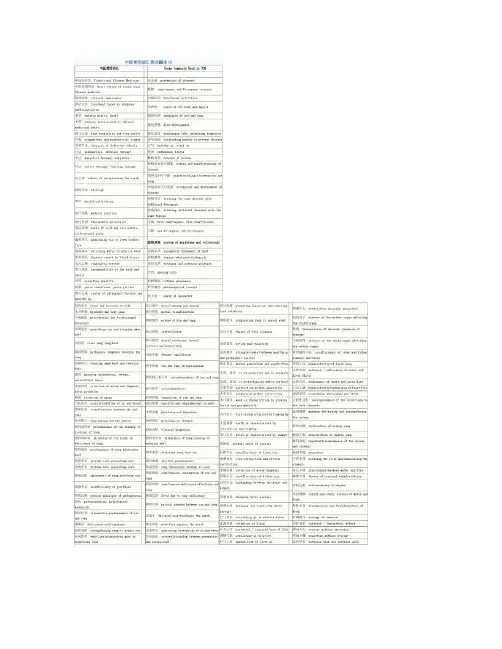
中医英语常用词汇英文翻译02气化不利dysfunction of qi in transformation畏寒喜热aversion to cold and preference for heat 气分热盛excessive heat at qi phase气郁化热stagnation of qi transforming into heat温养脏腑warming and nourishing the viscera瘀血阻络blood stasis obstructing the collaterals清肺润燥clearing the lung and moistening dryness破瘀通经breaking blood stasis to promote menstruation内伤头疼headache due to internal injury祛瘀eliminating stasis, expelling stasis逆传心包reverse transmission into the pericardium气不摄血failure of qi to check the blood宁心安神calming the heart and tranquilizing the mind血液循行circulation of the blood惊悸不安palpitation due to fright气的运动形式the moving styles of qi血液生成不足insufficient production of the blood平肝止血soothing the liver to stop bleeding血液亏虚deficiency of the blood离经之血abnormal flow of the blood津液的形状、功能与分布form, function, and distribution of the body fluid 气血生化之源source for the production and transformation of qi and blood 脉细无力thin and weak pulse肌肤干燥dry skin肌肤甲错squamous and dry skin血脉调和流畅smooth and normal flow of the blood脏腑火热炽盛exuberant fire and heat in the viscera机体正常水液normal fluid inside the body热迫血分heat invading the blood phase气滞津停retention of fluid due to stagnation of qi寒凝气滞stagnation of cold and qi身倦乏力lassitude气滞血瘀qi stagnation and blood stasis伤津脱液consumption and loss of the body fluid津液的营养和滋润作用the nourishing and moistening functions of the body fluid 津液的生成、输布和排泄production, distribution, and excretion of the body fluid 腹痛拒按unpalpable abdominal pain脾的“散精”功能the function of the spleen to “dissipate essence”津液不足insufficiency of the body fluid水液停聚retention of water奇经八脉eight extraordinary vessels, eight extraordinary meridians胃的“游溢精气”the function of the stomach to “distribute essence”津液生化匮乏scanty production of the body fluid津液的代谢平衡the metabolic balance of the body fluid热盛耗伤津液consumption of the body fluid due to excessive heat风为百病之长wind is the leading factor in causing various diseases水液代谢障碍disturbance of water metabolism气随津脱exhaustion of qi due to loss of body fluid水湿困脾dampness encumbering the spleen濡养肌肤moistening and nourishing the skin湿邪内盛exuberance of interior dampness经脉之海sea of meridians脾虚水肿edema due to spleen deficiency滋养脏腑moistening and nourishing the viscera运行全身气血transporting qi and blood in the whole body 十二经别twelve branches of meridians联络脏腑肢节connecting with viscera, limbs and joints 经别divergent meridians 循行路线running route经气meridian qi十二正经twelve regular meridians十二皮部twelve skin areas, twelve skin regions/divisions 经隧阻滞blockage of meridians十二经筋twelve meridian tendons经穴meridian acupoints, Jing-River acupoint饮食劳倦improper diet and overstrain经络辨证syndrome differentiation according to meridians 风寒感冒common cold due to wind-cold经络感传meridian conduction, channel transmission湿热泄泻diarrhea due to damp-heat经络现象meridian phenomena内生五邪five endogenous pathogenic factors经络阻滞blockage of meridians风邪外袭pathogenic wind attacking the superficies舒筋活络relaxing tendons and activating collaterals游走性关节疼痛migratory arthralgias刺血疗法blood-pricking therapy阳气衰退decline of yang-qi外感六淫attacked by six climate pathogenic factors六淫six climatic evils感受寒邪attacked by pathogenic cold经闭发肿amenorrhea with edema虚实夹杂deficiency complicated with excess, asthenia complicated with sthenia 邪正盛衰predominance or decline of pathogenic factors and healthy qi寒性凝滞cold tending to stagnate by nature病症的虚实变化asthenia and sthenia changes of disease腠理闭塞blockage of muscular interstices机体的抗病能力body resistance经脉拘急收引contraction of tendons五心烦热feverish sensation over the five centers湿邪困脾pathogenic dampness encumbering the spleen五心five centers (palms, soles and chest疾病的发生、发展与变化occurrence, development and changes of disease 生津安神promoting the production of body fluid and tranquilizing the mind 体质强弱conditions of constitution蓄血发黄jaundice due to blood accumulation气血功能紊乱dysfunction of qi and blood脾阳不振inactivation of spleen yang阴阳偏盛大relative predominance of yin and yang阴虚生内热yin deficiency generating interior heat五志过极extreme changes of emotions热极生风extreme heat producing wind精气夺则虚depletion of essence causing deficiency七情内伤internal injury due to emotional disorder阴阳互损mutual consumption of yin and yang饮食不节improper diet真热假寒true heat and false cold暴饮暴食craputence气机郁滞不畅stagnation of qi activity神昏谵语coma and delirium津液代谢失常disorder of fluid metabolism四诊合参combined use of the four diagnostic methods寒热往来alternate attacks of chill and fever精神活动mental activities津伤化燥consumption of fluid transforming into dryness 面部表情facial expressions风火胁痛hypochondriac pain due to wind-fire精充气足sufficient essence and abundant qi口眼歪斜wry mouth with distorted eyes, facial distortion 预后良好favorable prognosis湿浊内生endogenous turbid dampness表情淡漠apathetic facial expressions虚火上炎flaming of asthenia-fire精神不振dispiritedness邪气内陷internal invasion of pathogenic factors神志不清unconsciousness大肠热结retention of heat in the large intestine轻宣润燥dispersing lung qi and moistening dryness心脉瘀阻blood stasis in the heart vessels四肢抽搐convulsion of the limbs镜面舌mirror-like tongue脏腑辨证syndrome differentiation of viscera饥不欲食hunger without desire for food病位与病性location and nature of disease脉有胃气pulse with stomach qi表里同病disease involving both the exterior and interior清里泄热clearing away heat in the interior风热眩晕vertigo due to wind-heat寒证化热cold syndrome transforming into heat syndrome寒热错杂simultaneous occurrence of cold and heat舌淡苔白而润滑light-colored tongue with white and slippery coating 表邪入里invasion of the exterior pathogenic factors into the interior 祛风解痉expelling wind to relieve convulsion外感胃脘痛stomachache due to exogenous pathogenic factors医.学全.在.线网站恶寒与恶热aversion to cold and aversion to heat潮热盗汗tidal fever and night sweating口干唇裂dry mouth with cracked lips高热谵妄high fever with delirium脉数无力rapid and weak pulse和血止痛regulating blood to alleviate pain寒邪郁而化热stagnation of pathogenic cold changing into heat寒因寒用treating pseudo-cold syndrome with herbs of cold nature未病先防preventing measures taken before the occurrence of disease热因热用treating pseudo-heat syndrome with herbs of heat nature补气健脾invigorating qi and strengthening the spleen塞因塞用treating obstructive syndrome with tonifying therapy补血养心enriching blood to nourish the heart发汗解表relieving exterior syndrome by diaphoresis水气凌心water attacking the heart风热乳蛾tonsillitis due to wind-heat心悸多梦palpitation and dreaminess痰饮咳嗽cough due to fluid retention血为气母the blood serving as the mother of qi实热蕴结accumulation of sthenia-heat调摄精神regulating mental states舒肝和胃soothing the liver and harmonizing the stomach血脉流畅smooth circulation of blood清热泻火clearing away heat and reducing fire关节通利smooth movement of joints疏风泄热dispelling wind and reducing heat气机调畅free activity of qi行气消瘀activating qi to resolve stagnation益寿延年promoting longevity养血润肠nourishing the blood and moistening the intestine治病求本treatment of disease must concentrate on the principle cause of disease 因时、因地、因人制宜applying proper therapeutic measure in line with season, local conditions and individuality急则治其标relieving the secondary symptoms first in treating acute disease缓则治其本relieving the primary symptoms in treating chronic disease通腑泄热purging fu-organs to eliminate heat燥湿化痰drying dampness and resolving phlegm标本兼治treatment focusing on relieving both the secondary and primary symptoms 正虚邪实asthenia of healthy qi and sthenia of pathogenic factors痰湿壅肺accumulation of phlegm-dampness in the lung血枯经闭amenorrhea due to blood exhaustion祛虫消积removing parasites to eliminate accumulation中医英语翻译常用词汇英汉对照03中草药Chinese medicinal herbs炮制processing四气五味four properties and five tastes清除杂质eliminating impurity入药部分the part used for medical purpose作用和缓mild effect药物采集collection of herbs发散解表relieving exterior syndrome by dispersion收敛astringency方剂学science of prescriptions软坚散结softening hardness to dissipate stagnation配伍关系compatibility燥湿健脾drying dampness and strengthening the spleen组成规律prescription-formulating principle升降沉浮ascending, descending, sinking and floating方剂的加减modification of prescriptions归经meridian tropism剂型和剂量drug form and dosage用药禁忌contraindication in using herbs君臣佐使monarch, minister, assistant and guide药物用量dosage药物毒性toxicity of medicinal herbs辛温解表药relieving exterior syndrome with herbs pungent in taste and warm in nature 十八反与十九畏eighteen incompatible herbs and nineteen herbs of mutual antagonism 袪风湿药herbs for expelling wind and dampness调和诸药moderating the property of herbs胸痛彻背thoracic pain involving the back温经散寒warming meridians to dissipate cold清热凉血药herbs for clearing away heat and cooling blood宣肺平喘disperse lung qi to stop asthma引经报使guiding action灵活化裁flexible modification针灸疗法acupuncture and moxibustion therapy, acumox 清散郁热clearing away and dispersing stagnant heat针刺补泻reinforcing and reducing techniques for needling 随症加减modification according to symptoms针刺手法needling techniques, manipulation药物饮片processed herbs进针手法methods for inserting the needle内服散剂powder for oral taking针刺止痛alleviating pain with acupuncture外用膏剂medicinal extract for exterior application针刺麻醉acupuncture anesthesia, acu-anesthesia开水冲服mixing in boiled water for oral taking针感needling sensation浓缩浸膏condensed extract皮内针intradermal needle耳针疗法ear acupuncture treatment针刺的角度与深度angle and depth of needling提插捻转lifting, thrusting, swirling and rotating双手进针法insertion of needle with double hands水针疗法hydro-acupuncture therapy行针manipulating the needle头针疗法scalp-acupuncture therapy化脓灸blistering moxibustion推拿手法manipulations for tuina, manipulating techniques 瘢痕灸scarring moxibustion减轻疼痛alleviating pain艾炷灸moxibustion with moxa cone功法训练 exercise for practicing tuina 灯火灸 lamp moxibustion 放松肌肉 relaxing muscles 温针灸 warm needling method 解除肌肉紧张 relieving muscular tension 一指禅推法 pushing manipulation with one finger 活动受限 confined activity 点按法 point-pressing manipulation 关节脱位 dislocation of joint 大鱼际揉法 kneading manipulation with the large thenar 腰椎间盘突出 protrusion of lumbar vertebral disc 交替搓揉alternative rubbing and kneading 旋转复位 rotating reduction 腰肌劳损 injury of lumbar muscles 软组织损伤 injury of soft tissues 解除痉挛 relieving spasm 关节粘连僵硬adhesion and stiffness of joint 外感发热 exogenous fever 滑利关节 lubricating joint 脉象浮紧 floating and tense pulse 手法补泻 reinforcing and reducing manipulations 寒邪束表 pathogenic cold hampering the exterior拇指平推法 horizontal pushing with the thumb 邪热入里 interior invasion of pathogenic heat 午后潮热 afternoon tidal fever 四肢厥冷 cold limbs 热扰神明 heat disturbing mind 阳气不振 inactivation of yang-qi 形体消瘦 emaciation 少气懒言 lack of qi and no desire to speak 祛痰止咳药 herbs for eliminating phlegm and stopping cough。
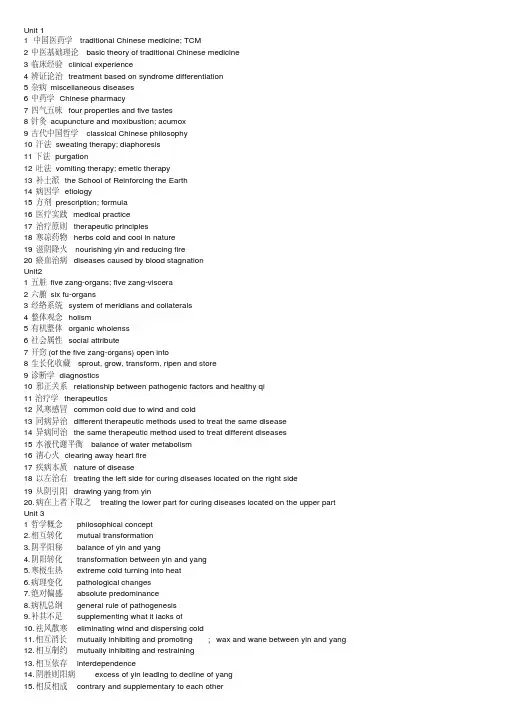
Unit 11 中国医药学traditional Chinese medicine; TCM2中医基础理论basic theory of traditional Chinese medicine3临床经验clinical experience4辨证论治treatment based on syndrome differentiation5杂病miscellaneous diseases6中药学Chinese pharmacy7四气五味four properties and five tastes8针灸acupuncture and moxibustion; acumox9古代中国哲学classical Chinese philosophy10汗法sweating therapy; diaphoresis11下法purgation12吐法vomiting therapy; emetic therapy13补土派the School of Reinforcing the Earth14病因学etiology15方剂prescription; formula16医疗实践medical practice17治疗原则therapeutic principles18寒凉药物herbs cold and cool in nature19滋阴降火nourishing yin and reducing fire20瘀血治病diseases caused by blood stagnationUnit21五脏five zang-organs; five zang-viscera2六腑six fu-organs3经络系统system of meridians and collaterals4整体观念holism5有机整体organic wholenss6社会属性social attribute7开窍(of the five zang-organs) open into8生长化收藏sprout, grow, transform, ripen and store9诊断学diagnostics10邪正关系relationship between pathogenic factors and healthy qi11治疗学therapeutics12风寒感冒common cold due to wind and cold13同病异治different therapeutic methods used to treat the same disease14异病同治the same therapeutic method used to treat different diseases15水液代谢平衡balance of water metabolism16清心火clearing away heart fire17疾病本质nature of disease18以左治右treating the left side for curing diseases located on the right side19从阴引阳drawing yang from yin20.病在上者下取之treating the lower part for curing diseases located on the upper part Unit 31哲学概念philosophical concept2.相互转化mutual transformation3.阴平阳秘balance of yin and yang4.阴阳转化transformation between yin and yang5.寒极生热extreme cold turning into heat6.病理变化pathological changes7.绝对偏盛absolute predominance8.病机总纲general rule of pathogenesis9.补其不足supplementing what it lacks of10.祛风散寒eliminating wind and dispersing cold11.相互消长mutually inhibiting and promoting;wax and wane between yin and yang12.相互制约mutually inhibiting and restraining精品文库16.有机整体organic whole17.阳损及阴impairment of yang involving yin18.阴阳两虚deficiency of both yin and yang19.虚寒证deficiency cold syndrome20.潜阳熄风suppressing yang and eliminating windUnit41 the theory of five elements 五行学说2 free development 条达舒畅3 to be generated and to generate生我,我生4 restraint in generation 生中有制5 over restriction and counter-restriction相乘相侮6 Wood over restricts earth because it is deficient.土虚木乘7 promotion, restriction, inhibition and transformation 生克制化8 disorder of a mother-organ involving its child-organ 母病及子9 insufficiency of essence and blood in the liver and kidney 肝肾精血不足10 blood deficiency in the heart and liver 心肝血虚11 exuberant fire in the heart心火亢盛12 insufficiency of liver yin 肝阴不足13 declination of kidney yang肾阳式微14 weakness of the spleen and stomach 脾胃虚弱15 soothing the liver and harmonizing the stomach 平肝和胃16 between water and fire水火不济Unit51 藏象学说doctrine of visceral manifestations2 五脏六腑five zang-organs and six fu-organs3 奇恒之腑extraordinary fu-organs4 水谷精微nutrients of water and food5 传化水谷transmitting and transforming water and food6 贮藏精气storing essence7 表里关系internal and external relationship8 治疗效应therapeutic effects9 临床实践clinical practice10 藏而不泻storage without discharge11泻而不藏discharge without storage12形体诸窍physical build and various orifices13开窍(of five zang-organs) open into14精神情志spirit and emotions15心藏神the heart storing spirit16肺藏魄the lung storing corporeal soul17肝藏魂the liver storing ethereal soul18脾藏意the spleen storing consciousness19肾藏志the kidney storing will20其华在面the luster manifesting upon the faceUnit61 心主血脉the heart governing blood and vessels2 心气充沛sufficiency of heart qi3 面色红润rosy complexion4 血液充盈sufficiency of blood5 脉道不利unsmooth vessels6 面色无华lusterless complexion7 脉象细弱thin and weak pulse8 心藏神the heart storing spirit9 汗血同源sweat and blood sharing the same origin精品文库10 升降出入ascending, descending, going out and going in11宣发肃降dispersion, purification and descent12通调水道regulating water passage13脾主运化the spleen governing transportation and transformation14水谷精微nutrients of water and food15水液停滞stoppage of water and fluid16后天之本acquired base of life17调畅气机regulating qi activity18肝气逆上upward adverse flow of liver qi19先天之精innate essence20肾主纳气the kidney receiving qiUnit71 奇恒之府extraordinary fu-organs2 孤俯isolated fu-organ3 腐熟水谷digest water and food4 魄门anus5 肝之余其surplus part of liver qi6 上焦upper energizer7 泌别清浊separating the lucid from the turbid8 食物残渣residue of foods9 大肠主津The large intestine governs thin body fluid10精汁(胆汁)bile11小肠主液The small intestine governs thick body fluid12初步消化primary digestion13精气essential qi14七冲门the seven important portals15胆主决断The gallbladder is responsible for making judgment16排泄糟粕discharge waste17月经来潮occurrence of menstruation18吸门inhaling portal19形态中空morphological hollowness20传化水谷transporting and transforming water and foodUnit81 先天禀赋innateness2 精微物质nutrients; refined substance3 血液循行blood circulation4 水液代谢water metabolism5 气的运动形式way of qi movement6 气的升降出入ascending, descending, exiting and entering movements of qi7 气机调畅normal function of qi activity8生命的原动力primary motive force of life9 温养腑脏warming and nourishing the viscera10 腑脏经络之气qi of the viscera and meridians11气机qi activity12气化qi transformation13先天之气innate qi14后天之气acquired qi15正气healthy qi16邪气pathogenic factors17元气primordial qi18宗气thoracic qi19营气nutritive qi20卫气defensive qi精品文库21腠理striae and intersticesUnit91气生血qi promoting the production of blood2气行血qi promoting the flow of blood3气摄血qi commanding blood4血载气blood carrying qi5血生气blood generating qi6气生津液qi promoting the production of body fluid7气行津液qi promoting the flow of body fluid8气摄津液qi commanding body fluid9津液载气body fluid carrying qi10津液生气body fluid generating qi11津血同源body fluid and blood sharing the same origin12气随液脱exhaustion of qi due to loss of body fluid13气随血脱exhaustion of qi due to hemorrhage14气随津泄loss of qi due to profuse sweating15气行则血行,气滞则血瘀。

中医英语短语翻译 1-10单元Unit 11.中国医药学traditional Chinese medicine; TCM2中医基础理论basic theory of traditional Chinese medicine 3临床经验clinical experience4辨证论治treatment based on syndrome differentiation5杂病miscellaneous diseases6中药学Chinese pharmacy7四气五味four properties and five tastes8针灸acupuncture and moxibustion; acumox9古代中国哲学classical Chinese philosophy10汗法sweating therapy; diaphoresis11下法purgation12吐法vomiting therapy; emetic therapy13补土派the School of Reinforcing the Earth14病因学etiology15方剂prescription; formula16医疗实践medical practice17治疗原则therapeutic principles18寒凉药物herbs cold and cool in nature19滋阴降火 nourishing yin and reducing fire20瘀血治病diseases caused by blood stagnationUnit21五脏five zang-organs; five zang-viscera2六腑six fu-organs3经络系统system of meridians and collaterals4整体观念holism5有机整体organic wholenss6社会属性social attribute7开窍(of the five zang-organs) open into8生长化收藏sprout, grow, transform, ripen and store9诊断学diagnostics10邪正关系relationship between pathogenic factors and healthy qi11治疗学therapeutics12风寒感冒common cold due to wind and cold13同病异治different therapeutic methods used to treat the same disease 14异病同治the same therapeutic method used to treat different diseases 15水液代谢平衡balance of water metabolism 16清心火clearing away heart fire17疾病本质nature of disease18以左治右treating the left side for curing diseases located on the right side19从阴引阳drawing yang from yin20.病在上者下取之treating the lower part for curing diseases located on the upper part Unit 31哲学概念 philosophical concept2.相互转化 mutual transformation3.阴平阳秘 balance of yin and yang4.阴阳转化 transformation between yin and yang5.寒极生热 extreme cold turning into heat6.病理变化 pathological changes7.绝对偏盛 absolute predominance8.病机总纲 general rule of pathogenesis9.补其不足 supplementing what it lacks of10.祛风散寒 eliminating wind and dispersing cold11.相互消长 mutually inhibiting and promoting;wax and wane between yin and yang12.相互制约 mutually inhibiting and restraining13.相互依存 interdependence14.阴胜则阳病 excess of yin leading to decline of yang15.相反相成 contrary and supplementary to each other16.有机整体 organic whole17.阳损及阴 impairment of yang involving yin18.阴阳两虚 deficiency of both yin and yang 19.虚寒证 deficiency cold syndrome20.潜阳熄风 suppressing yang and eliminating windUnit41 五行学说 the theory of five elements2 条达舒畅 free development3 生我,我生 to be generated and to generate4 生中有制 restraint in generation5 相乘相侮 over restriction and counter-restriction6 土虚木乘Wood over restricts earth because it is deficient.7 生克制化 promotion, restriction, inhibition and transformation8母病及子 disorder of a mother-organ involving its child-organ9 肝肾精血不足 insufficiency of essence and blood in the liver and kidney10 心肝血虚 blood deficiency in the heart and liver11 心火亢盛 exuberant fire in the heart12 肝阴不足 insufficiency of liver yin13 肾阳式微 declination of kidney yang14 脾胃虚弱 weakness of the spleen and stomach15 平肝和胃 soothing the liver and harmonizing the stomach16 水火不济between water and fireUnit51 藏象学说doctrine of visceral manifestations2 五脏六腑five zang-organs and six fu-organs3 奇恒之腑extraordinary fu-organs4 水谷精微nutrients of water and food5 传化水谷transmitting and transforming water and food6 贮藏精气storing essence7 表里关系internal and external relationship8 治疗效应therapeutic effects9 临床实践clinical practice10 藏而不泻storage without discharge11泻而不藏discharge without storage12形体诸窍physical build and various orifices13开窍(of five zang-organs) open into14精神情志spirit and emotions15心藏神the heart storing spirit16肺藏魄the lung storing corporeal soul17肝藏魂the liver storing ethereal soul18脾藏意the spleen storing consciousness19肾藏志the kidney storing will20其华在面the luster manifesting upon the faceUnit61 心主血脉 the heart governing blood and vessels2 心气充沛 sufficiency of heart qi3 面色红润 rosy complexion4 血液充盈 sufficiency of blood5 脉道不利 unsmooth vessels6 面色无华 lusterless complexion7 脉象细弱 thin and weak pulse8 心藏神 the heart storing spirit9 汗血同源 sweat and blood sharing the same origin10 升降出入 ascending, descending, going out and going in11宣发肃降 dispersion, purification and descent12通调水道 regulating water passage13脾主运化 the spleen governing transportation and transformation 14水谷精微 nutrients of water and food15水液停滞 stoppage of water and fluid16后天之本 acquired base of life17调畅气机 regulating qi activity18肝气逆上 upward adverse flow of liver qi19先天之精 innate essence20肾主纳气 the kidney receiving qiUnit71 奇恒之府extraordinary fu-organs2孤俯isolated fu-organ3 腐熟水谷digest water and food4 魄门anus5 肝之余其surplus part of liver qi6 上焦upper energizer7 泌别清浊separating the lucid from the turbid8 食物残渣residue of foods9 大肠主津The large intestine governs thin body fluid10精汁(胆汁)bile11小肠主液The small intestine governs thick body fluid12初步消化primary digestion13精气essential qi14七冲门the seven important portals15胆主决断The gallbladder is responsible for making judgment 16排泄糟粕discharge waste17月经来潮occurrence of menstruation18吸门inhaling portal19形态中空morphological hollowness20传化水谷transporting and transforming water and foodUnit81 先天禀赋innateness2 精微物质nutrients; refined substance3 血液循行blood circulation4 水液代谢water metabolism5 气的运动形式way of qi movement6 气的升降出入ascending, descending, exiting and entering movements of qi 7 气机调畅normal function of qi activity8生命的原动力primary motive force of life9 温养腑脏warming and nourishing the viscera10 腑脏经络之气qi of the viscera and meridians11气机qi activity12气化qi transformation13先天之气innate qi14后天之气acquired qi15正气healthy qi16邪气pathogenic factors17元气primordial qi18宗气thoracic qi19营气nutritive qi20卫气defensive qi21腠理striae and intersticesUnit91气生血qi promoting the production of blood2气行血qi promoting the flow of blood3气摄血qi commanding blood4血载气blood carrying qi5血生气blood generating qi6气生津液qi promoting the production of body fluid7气行津液qi promoting the flow of body fluid8气摄津液qi commanding body fluid9津液载气body fluid carrying qi10津液生气body fluid generating qi11津血同源body fluid and blood sharing the same origin12气随液脱exhaustion of qi due to loss of body fluid13气随血脱exhaustion of qi due to hemorrhage14气随津泄loss of qi due to profuse sweating15气行则血行,气滞则血瘀。
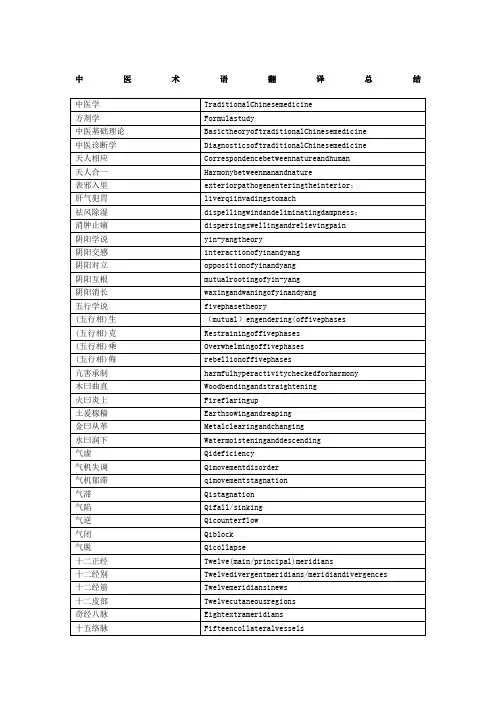
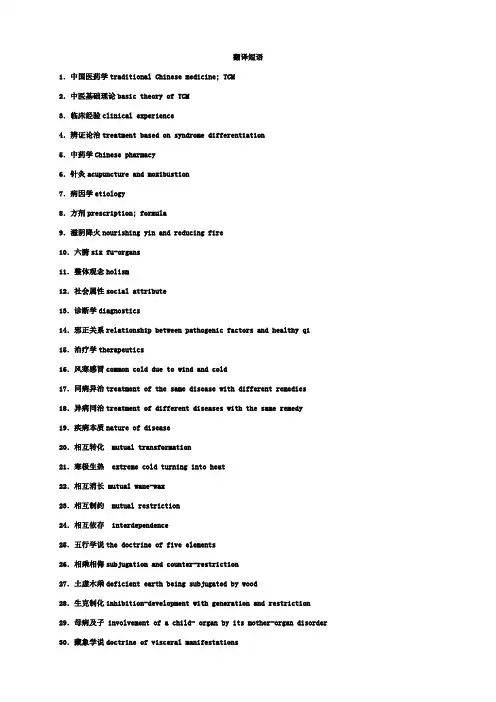
翻译短语1.中国医药学traditional Chinese medicine; TCM2.中医基础理论basic theory of TCM3.临床经验clinical experience4.辨证论治treatment based on syndrome differentiation5.中药学Chinese pharmacy6.针灸acupuncture and moxibustion7.病因学etiology8.方剂prescription; formula9.滋阴降火nourishing yin and reducing fire10.六腑six fu-organs11.整体观念holism12.社会属性social attribute13.诊断学diagnostics14.邪正关系relationship between pathogenic factors and healthy qi 15.治疗学therapeutics16.风寒感冒common cold due to wind and cold17.同病异治treatment of the same disease with different remedies 18.异病同治treatment of different diseases with the same remedy19.疾病本质nature of disease20.相互转化 mutual transformation21.寒极生热 extreme cold turning into heat22.相互消长 mutual wane-wax23.相互制约 mutual restriction24.相互依存 interdependence25.五行学说the doctrine of five elements26.相乘相侮subjugation and counter-restriction27.土虚木乘deficient earth being subjugated by wood28.生克制化inhibition-development with generation and restriction 29.母病及子 involvement of a child- organ by its mother-organ disorder 30.藏象学说doctrine of visceral manifestations31.奇恒之腑extraordinary fu-organs32.水谷精微essence of water and food33.临床实践clinical practice34.藏而不泻storage without discharge/excretion35.心气充沛sufficiency of heart qi36.血液充盈sufficiency of blood37.汗血同源sweat and blood sharing the same origin38.脾主运化the spleen governing transportation and transformation39.后天之本origin of acquired constitution40.奇恒之腑extraordinary fu-organs41.上焦upper energizer42.泌别清浊separating the lucid from the turbid43.初步消化 primary digestion44.月经来潮occurrence of menstruation45.先天禀赋innateness46.水液代谢water metabolism47.气机调畅smoothness of qi movement48.气机qi movement49.气化qi transformation50.先天之气innate qi51.后天之气acquired qi52.气生血qi generating blood53.气行血qi propelling blood54.津血同源body fluid and blood sharing the same origin55.气为血帅,血为气母Qi serves as commander of blood and blood does as mother of qi 56.益气固脱nourishing qi to stop collapse57.经络学说meridian theory58.经络系统meridian system59.十二正经twelve regular meridians60.奇经八脉eight extraordinary meridians61.十二经别twelve meridians’ divergences62.外感六淫six exogenous pathogenic factors63.风邪外袭pathogenic wind attacking the exterior64.感受寒邪attack/invade by pathogenic cold65.阴虚生内热production of endogenous heat due to yin deficiency66.七情内伤internal impairment due to seven emotions67.体质强弱 (body )constitutional state68.五心烦热feverish sensation in the five centers (palms, soles, and chest) 69.五志过极extreme changes of five emotions70.阴阳互损mutual involvement of yin and yang71.精充气足 sufficient essence and abundant qi72.肌肤甲错squamous and dry skin73.预后良好favorable prognosis74.脉象pulse conations75.表里同病disease involving both exterior and interior76.寒热错杂co-existence of cold and heat/ mixture of cold and heat77.真寒假热true cold with false heat78.寒证化热cold syndrome transforming into heat one79.热证转寒transformation of heat syndrome into cold one80.潮热盗汗tidal fever and night sweating81.中草药Chinese medicinal herbs82.四气五味four properties and five flavors83.燥湿健脾drying dampness to invigorate the spleen84.升降沉浮ascending, descending, sinking and floating85.归经channel tropism of medicines86.用药禁忌medication contraindication87.方剂学science of prescription88.方剂的加减modification of a prescription89.剂型与剂量drug form and dosage90.药物毒性toxicity of medicinal herb91.引经报使guiding action92.药物饮片 herbal slice93.针灸疗法acupuncture and moxibustion (therapy)94.针刺补泻reinforcing and reducing95针刺止痛analgesia by acupuncture96.针刺麻醉acupuncture anesthesia97.耳针疗法ear acupuncture (therapy)98.提插捻转lifting, thrusting, twisting and rotating (techniques)翻译句子1.中国医药学有数千年的历史,是中国人民长期同疾病作斗争的经验总结。
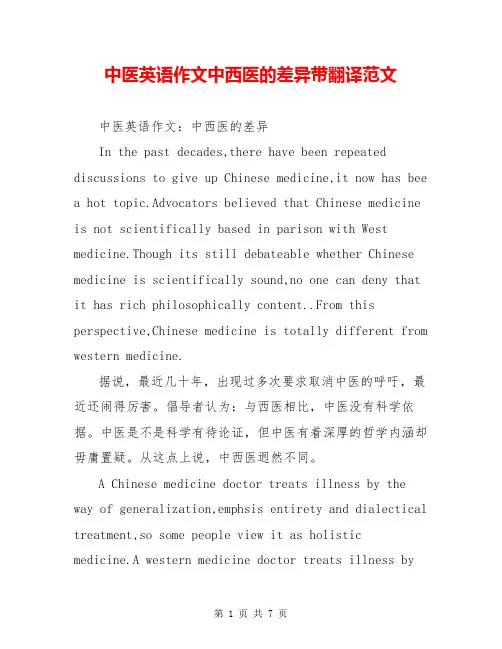
中医英语作文中西医的差异带翻译范文中医英语作文:中西医的差异In the past decades,there have been repeated discussions to give up Chinese medicine,it now has bee a hot topic.Advocators believed that Chinese medicine is not scientifically based in parison with West medicine.Though its still debateable whether Chinese medicine is scientifically sound,no one can deny that it has rich philosophically content..From this perspective,Chinese medicine is totally different from western medicine.据说,最近几十年,出现过多次要求取消中医的呼吁,最近还闹得厉害。
倡导者认为:与西医相比,中医没有科学依据。
中医是不是科学有待论证,但中医有着深厚的哲学内涵却毋庸置疑。
从这点上说,中西医迥然不同。
A Chinese medicine doctor treats illness by the way of generalization,emphsis entirety and dialectical treatment,so some people view it as holistic medicine.A western medicine doctor treats illness bythe symptoms.For exle,if you have a sore throat,the western medicine doctor considers it as a throat problem,while a Chinese medicine doctor may link it to your stomach trouble.中医通常从宏观角度认识问题,强调整体性和辨证施治,有人称其为整体医学。
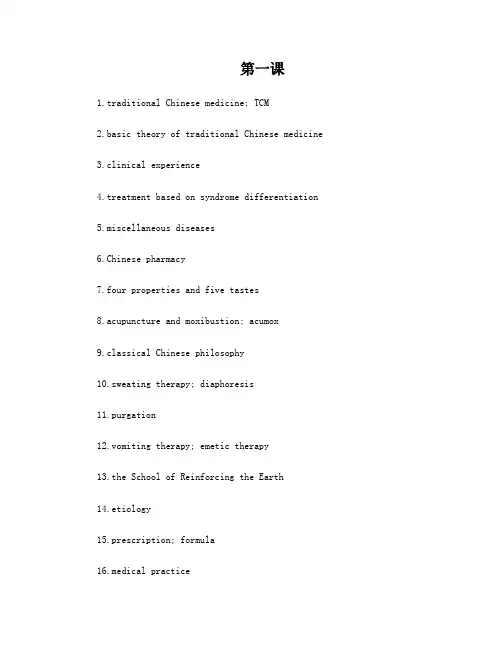
第一课1.traditional Chinese medicine; TCM2.basic theory of traditional Chinese medicine3.clinical experience4.treatment based on syndrome differentiation5.miscellaneous diseases6.Chinese pharmacy7.four properties and five tastes8.acupuncture and moxibustion; acumox9.classical Chinese philosophy10.sweating therapy; diaphoresis11.purgation12.vomiting therapy; emetic therapy13.the School of Reinforcing the Earth14.etiology15.prescription; formula16.medical practice17.therapeutic principles18.herbs cold and cool in nature19.nourishing yin and reducing fire20.diseases caused by blood stagnation一.句子翻译1.TCM has a history of thousands of years and is a summary of the Chinese people’s experiencein their struggle against diseases.2.TCM has a unique and integrated theoretical system.3.TCM is a science that studies the rules of life as well as the occurrence, progress, preventionand treatment of diseases.4.Yellow Emperor’s Canon of Medicine has laid a solid foundation for the formation oftheoretical system of traditional Chinese medicine.5.Classic of Difficulties has supplemented what was unaddressed in the Yellow Emperor’s Canonof Medicine in many respects, especially in pulse lore.6.Discussion on the Causes and Symptoms of Various Diseases is the earliest extant monographon the causes and symptoms of diseases in China.7.Yang is usually excessive while yin is frequently deficient.8.Internal impairment of the spleen and stomach causes various diseases.pendium of Materia Medica is recognized as a monumental workin the history of Chinesemateria medica and a great contribution to the development of pharmacology in the world.10.Traditional Chinese materia medica includes not only medicinal herbs, but also minerals andanimal parts.11.In the Jin and Yuan Dynasties, there appeared the so-called four great medical schools.12.Zhang Congzheng believed that all diseases were caused by exogenous pathogenic factors andadvocated that pathogenic factors should be driven out by means of diaphoresis, emesis and purgation.13.Liu Wansu believed that “fire-heat” was the main cause of a variety of diseases and thatthese diseases should should be treated with drugs cold and cool in nature.14.Li Gao held that “internal impairment of the spleen and stomach would bring about diseases”and emphasized that the most important thing in clinical treatment was to warm and invigorate the spleen and stomach.15.Zhu Danxi b elieved that “yang is usually excessive while yin is frequently deficient” andadvocated the remedies of nourishing yin and reducing fire in treatment of diseases. 16.Study on Warm Disease is a clinical specialty focusing on the occurrence, progress, diagnosisand treatment of warm diseases.17.The School of Warm Disease has developed the rules of treatment of warm disease based onsyndrome differentiation in light of defensive phase, qi phase, nutritive phase, blood phase and triple energizer.18.Wang Qingren in the late Qing Dynasty corrected mistakes about anatomy made in ancient medicalbooks and advocated the theory that diseases were caused by blood stagnation.19.Integrated traditional Chinese and Western medicine has paved a new way for the developmentand modernization of traditional Chinese medicine.20.Great progress has been made in systematic and experimental study of the basic theory oftraditional Chinese medicine.第二课1.five zang-organs; five zang-viscera2.six fu-organs3.system of meridians and collaterals4.holismanic wholenss6.social attribute7.(of the five zang-organs) open into8.sprout, grow, transform, ripen and store9.diagnostics10.relationship between pathogenic factors and healthy qi11.therapeuticsmon cold due to wind and cold13.different therapeutic methods used to treat the same disease14.the same therapeutic method used to treat different diseases15.balance of water metabolism16.clearing away heart fire17.nature of disease18.treating the left side for curing diseases located on the right side19.drawing yang from yin20.treating the lower part for curing diseases located on the upper part一.句子翻译1.The theoretical system of TCM is mainly characterized by holism and treatment based onsyndrome differentiation.2.TCM believes that the human body is an organic whole.3.The constituent parts of the human body are interdependent in physiology and mutuallyinfluential in pathology.4.The holism permeates through the physiology, pathology, diagnosis, syndrome differentiationand treatment of diseases.5.Changes in the natural world directly or indirectly influence the human body.6.Qi and blood in the human body tend to flow to the exterior in spring and summer and to theinterior in autumn and winter.7.The heart opens into the tongue and is internally and externally related to the smallintestine.8.TCM has noticed that the fact that social activitypsychologically influences human beings.9.According to TCM, the body and spirit coexist, interacting with each other and influencingeach other.10.Yang qi in the human body tends to flow to the exterior in the daytime and to the interiorat night.11.Regional differences, to some extent, influences the physiological activities of the humanbody.12.Syndrome is a generalization of pathological changes at acertain stage during the courseof a disease.13.Treatment based on syndrome differentiation, one of the characteristics of TCM, is the basicprinciple in TCM for understanding and treating diseases.14.Syndrome includes the location, cause and nature of a disease as well as the state ofpathogenic factors and healthy qi.15.Differentiation of syndrome and treatment of disease are two inseparable aspects indiagnosing and treating diseases.16.Clinically doctors pay great attention to the differentiation of diseases. Buttherapeutically they care more about the differentiation of syndromes because diseases can be cured by treating syndromes.17.Syndrome can comprehensively and accurately reveal the nature ofa disease.18.Different diseases may demonstrate the same syndrome because of the similarity inpathogenesis.19.If the syndrome of middle qi sinking appears in two different diseases, they all can be treatedby the therapeutic method for elevating middle qi.20.The treatment of diseases in TCM does not only simply concentrate on the difference orsimilarity of diseases, but on the difference or similarity of pathogenesis.第三课一.术语翻译1.philosophical concept2.mutual transformation3.balance of yin and yang4.transformation between yin and yang5.extreme cold turning into heat6.pathological changes7.absolute predominance8.general rule of pathogenesis9.supplementing what it lacks of10.eliminating wind and dispersing cold11.mutually inhibiting and promoting12.mutually inhibiting and restraining13.interdependence14.excess of yin leading to decline of yang15.contrary and supplementary to each otheranic whole17.impairment of yang involving yin18.deficiency of both yin and yang19.deficiency cold syndrome20.suppressing yang and eliminating wind二.句子翻译1.Yin and yang are two concepts in classical Chinese philosophy.2.Yin and yang are the summarization of the attributes of two opposite aspects of interrelatedthings or phenomena in nature.3.The formation, development and changes of all things in the universe are the result of themovement of yin and yang that oppose to each other and unite with each other.4.The celestial qi pertains to yang because it is light and lucid, while the terrestrial qi pertains toyin because it is heavy and turbid.5.The course of mutual restraint and inhibition between yin and yang signifies their progress inmutual reduction and promotion.6.Yin cannot exist alone without yang and vice versa.7.Separation of yin and yang results in exhaustion of essence.8.Only through constant reduction, growth and balance can the normal development of things bemaintained.9.Under given conditions, either yin or yang may transform into its counterpart.10.Sprout of things signifies transformation while extreme development of things indicateschange.11.Yin and yang are indispensable the human body.12.Functions pertain to yang while substances to yin.13.If yin and yang fail to promote each other and are thus separated from each other, it will leadto the end of life.14.No matter how complicated pathological changes of a disease are, they are nothing more thanrelative predominance of yin or yang.15.The so-called healthy qi refers to the structure and functions of the body, including bodyresistance against diseases.16.If any part of the body, either yin or yang, becomes deficient to a certain extent, it willinevitably lead to insufficiency of the other part.17.Imbalance between yin and yang is the intrinsic factor responsible for the occurrence andprogress of a disease.18.The manifestations of complexion can tell whether a disease pertains to yin or yang in nature.19.The basic therapeutic principle is to supplement insufficiency and reduce excess.20.Only when appropriate herbs are chosen can excellent therapeutic effects be ensured.第四课一.术语翻译1.the doctrine of five elements; the theory of five phases2.free development3.to be generated and to generate4.restraint in generation5.Wood is characterized by growing freely and peripherally.6.Earth is characterized by cultivation and reaping.7.Water is characterized by moistening and downward flowing.8.over restriction and counter-restriction9.Wood over restricts earth because it is deficient.10.promotion, restriction, inhibition and transformation11.disorder of a mother-organ involving its child-organ12.insufficiency of essence and blood in the liver and kidney13.blood deficiency in the heart and liver14.exuberant fire in the heart15.insufficiency of liver yin16.declination of kidney yang17.weakness of the spleen and stomach18.soothing the liver and harmonizing the stomach19.insufficiency of kidney yin20.balance between water and fire二.句子翻译1.Wood, fire, earth, metal and water are the five most essential materials indispensable to humanexistence.2.The formation of the theoretical system of TCM was deeply influenced by the doctrine of fiveelements.3.Water is characterized by moistening and downward flow.4.The liver pertains to wood because it controls elevation.5.The spleen pertains to earth because it controls transportationand transformation.6.The kidney pertains to water because it controls water metabolism.7.Restriction implies that one thing brings under control orrestraint of the other.8.Since wood generates fire, wood is the generator of fire; sincefire generates earth, fire is thegenerator of earth.9.Subjugation or over restriction means to launch a violent attack when a counterpart is weak.10.When wood is too strong, it will over restrict the spleen and counter-restrict metal.11.Since the heart can warm the body, it pertains to fire.12.The liver stores blood to complement the liver.13.The kidney stores essence to nourish blood in the liver.14.The idea that the disorder of a child-organ attacks the mother-organs means that the diseaseis transmitted from a child-organ to its mother-organ.15.The human body is an organic whole. So disorders of the internal organs can be manifested overthe surface of the body.16.Restriction includes over restriction and counter-restriction, both of which are abnormalrestriction among the five elements.17.The basic relationships among the five elements are generation, restriction, over restrictionand counter-restriction.18.The one that generates is the mother-element while the one that is being generated is thechild-element.19.Clinically the doctrine of five elements is used to decide therapeutic principles and methods.20.The doctrine of five elements obviously has certain limitations and is still in need of furtherimprovement.第五课一.术语翻译1.doctrine of visceral manifestations2.five zang-organs and six fu-organs3.extraordinary fu-organs4.nutrients of water and food5.transmitting and transforming water and food6.storing essence7.internal and external relationship8.therapeutic effects9.clinical practice10.storage without discharge11.discharge without storage12.physical build and various orifices13.(of five zang-organs) open into14.spirit and emotions15.the heart storing spirit16.the lung storing corporeal soul17.the liver storing ethereal soul18.the spleen storing consciousness19.the kidney storing will20.the luster manifesting upon the face二.句子翻译1.The theory of visceral manifestation studies the physiological functions and pathologicalchanges of viscera and their relations.2.The theory of visceral manifestation plays an important role in the theoretical system of TCM.3.The common physiological function of the five zang-organs is to transform and store essence.4.The common physiological function of the six fu-organs is to receive, transport and transformwater and food.5.Diseases of the zang-organs are often of deficiency in nature while diseases of the fu-organsare frequently of excess in nature.6.Excess of zang-organs can be treated by purging the corresponding fu-organs while deficiencyof fu-organs can be treated by reinforcing the related zang-organs.mon cold due to invasion of cold into the skin is often characterized by stuffy nose, runningnose and cough.8.Kidney essence is helpful for promoting the growth of skeleton.9.The heart and the small intestine are internally and externally related to each other.10.The five zang-organs, the body and all the orifices form an organic whole.11.The spleen open into the mouth and its luster is manifested over the lips.12.The physiological functions of the five zang-organs are closely associated with the state ofspirit and mind.13.The physiological functions of the five zang-organs play a leading role in the physiologicalfunctions of the whole body.14.The normal relationship between the five zang-organs and the body and all the orifices is key tothe relative stability of the internal environment of the body.15.The normal relationship between the five zang-organs and the body and all the orificesmaintains the relative balance between the internal environment and external environment of the body.16.Disorder of spirit, emotions and mental activity affects the physiological functions of the fivezang-organs.17.The formation of the doctrine of visceral manifestation was, toa certain extent, based on theknowledge of anatomy in ancient times.18.The state of the internal organs must be manifested externally.19.The knowledge about the viscera in the doctrine of visceral manifestation has exceeded the继续阅读。
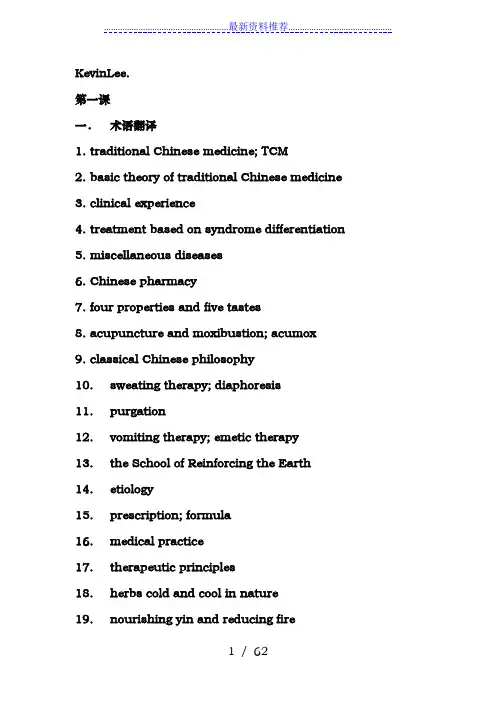
KevinLee.第一课一.术语翻译1.traditional Chinese medicine; TCM2.basic theory of traditional Chinese medicine3.clinical experience4.treatment based on syndrome differentiation5.miscellaneous diseases6.Chinese pharmacy7.four properties and five tastes8.acupuncture and moxibustion; acumox9.classical Chinese philosophy10.sweating therapy; diaphoresis11.purgation12.vomiting therapy; emetic therapy13.the School of Reinforcing the Earth14.etiology15.prescription; formula16.medical practice17.therapeutic principles18.herbs cold and cool in nature19.nourishing yin and reducing fire20.diseases caused by blood stagnation二.句子翻译1.TCM has a history of thousands of years and is a summaryof the Chinese people’s experience in their struggle against diseases.2.TCM has a unique and integrated theoretical system.3.TCM is a science that studies the rules of life as well as theoccurrence, progress, prevention and treatment of diseases.4.Yellow Emperor’s Canon of Medicine has laid a solidfoundation for the formation of theoretical system of traditional Chinese medicine.5.Classic of Difficulties has supplemented what wasunaddressed in the Yellow Emperor’s Canon of Medicine in many respects, especially in pulse lore.6.Discussion on the Causes and Symptoms of VariousDiseases is the earliest extant monograph on the causes and symptoms of diseases in China.7.Yang is usually excessive while yin is frequently deficient.8.Internal impairment of the spleen and stomach causesvarious diseases.pendium of Materia Medica is recognized as amonumental work in the history of Chinese materia medica and a great contribution to the development of pharmacology in the world.10.Traditional Chinese materia medica includes not onlymedicinal herbs, but also minerals and animal parts. 11.In the Jin and Yuan Dynasties, there appeared theso-called four great medical schools.12.Zhang Congzheng believed that all diseases werecaused by exogenous pathogenic factors and advocated that pathogenic factors should be driven out by means of diaphoresis, emesis and purgation.13.Liu Wansu believed that “fire-heat”was the maincause of a variety of diseases and that these diseases should should be treated with drugs cold and cool in nature.14.Li Gao held that “internal impairment of the spleenand stomach would bring about diseases”and emphasized that the most important thing in clinical treatment was to warm and invigorate the spleen and stomach.15.Zhu Danxi believed that “yang is usually excessivewhile yin is frequently deficient”and advocated theremedies of nourishing yin and reducing fire in treatment of diseases.16.Study on Warm Disease is a clinical specialty focusingon the occurrence, progress, diagnosis and treatment of warm diseases.17.The School of Warm Disease has developed the rules oftreatment of warm disease based on syndrome differentiation in light of defensive phase, qi phase, nutritive phase, blood phase and triple energizer.18.Wang Qingren in the late Qing Dynasty correctedmistakes about anatomy made in ancient medical books and advocated the theory that diseases were caused by blood stagnation.19.Integrated traditional Chinese and Western medicinehas paved a new way for the development and modernization of traditional Chinese medicine.20.Great progress has been made in systematic andexperimental study of the basic theory of traditional Chinese medicine.第二课一.术语翻译1.five zang-organs; five zang-viscera2.six fu-organs3.system of meridians and collaterals4.holismanic wholenss6.social attribute7.(of the five zang-organs) open into8.sprout, grow, transform, ripen and store9.diagnostics10.relationship between pathogenic factors and healthy qi11.therapeuticsmon cold due to wind and cold13.different therapeutic methods used to treat the samedisease14.the same therapeutic method used to treat differentdiseases15.balance of water metabolism16.clearing away heart fire17.nature of disease18.treating the left side for curing diseases located on theright side19.drawing yang from yin20.treating the lower part for curing diseases located onthe upper part二.句子翻译1.The theoretical system of TCM is mainly characterized byholism and treatment based on syndrome differentiation.2.TCM believes that the human body is an organic whole.3.The constituent parts of the human body areinterdependent in physiology and mutually influential in pathology.4.The holism permeates through the physiology, pathology,diagnosis, syndrome differentiation and treatment of diseases.5.Changes in the natural world directly or indirectlyinfluence the human body.6.Qi and blood in the human body tend to flow to the exteriorin spring and summer and to the interior in autumn and winter.7.The heart opens into the tongue and is internally andexternally related to the small intestine.8.TCM has noticed that the fact that social activitypsychologically influences human beings.9.According to TCM, the body and spirit coexist, interactingwith each other and influencing each other.10.Yang qi in the human body tends to flow to the exteriorin the daytime and to the interior at night.11.Regional differences, to some extent, influences thephysiological activities of the human body.12.Syndrome is a generalization of pathological changesat a certain stage during the course of a disease.13.Treatment based on syndrome differentiation, one ofthe characteristics of TCM, is the basic principle in TCM for understanding and treating diseases.14.Syndrome includes the location, cause and nature of adisease as well as the state of pathogenic factors and healthy qi.15.Differentiation of syndrome and treatment of diseaseare two inseparable aspects in diagnosing and treating diseases.16.Clinically doctors pay great attention to thedifferentiation of diseases. But therapeutically they care more about the differentiation of syndromes because diseases can be cured by treating syndromes.17.Syndrome can comprehensively and accurately revealthe nature of a disease.18.Different diseases may demonstrate the samesyndrome because of the similarity in pathogenesis.19.If the syndrome of middle qi sinking appears in twodifferent diseases, they all can be treated by the therapeutic method for elevating middle qi.20.The treatment of diseases in TCM does not only simplyconcentrate on the difference or similarity of diseases, but on the difference or similarity of pathogenesis.第三课一.术语翻译1.philosophical concept2.mutual transformation3.balance of yin and yang4.transformation between yin and yang5.extreme cold turning into heat6.pathological changes7.absolute predominance8.general rule of pathogenesis9.supplementing what it lacks of10.eliminating wind and dispersing cold11.mutually inhibiting and promoting12.mutually inhibiting and restraining13.interdependence14.excess of yin leading to decline of yang15.contrary and supplementary to each otheranic whole17.impairment of yang involving yin18.deficiency of both yin and yang19.deficiency cold syndrome20.suppressing yang and eliminating wind三.句子翻译1.Yin and yang are two concepts in classical Chinesephilosophy.2.Yin and yang are the summarization of the attributes oftwo opposite aspects of interrelated things or phenomena in nature.3.The formation, development and changes of all things inthe universe are the result of the movement of yin and yang that oppose to each other and unite with each other.4.The celestial qi pertains to yang because it is light andlucid, while the terrestrial qi pertains to yin because it is heavy and turbid.5.The course of mutual restraint and inhibition between yinand yang signifies their progress in mutual reduction and promotion.6.Yin cannot exist alone without yang and vice versa.7.Separation of yin and yang results in exhaustion ofessence.8.Only through constant reduction, growth and balance canthe normal development of things be maintained.9.Under given conditions, either yin or yang may transforminto its counterpart.10.Sprout of things signifies transformation while extremedevelopment of things indicates change.11.Yin and yang are indispensable the human body.12.Functions pertain to yang while substances to yin.13.If yin and yang fail to promote each other and are thusseparated from each other, it will lead to the end of life. 14.No matter how complicated pathological changes of adisease are, they are nothing more than relative predominance of yin or yang.15.The so-called healthy qi refers to the structure andfunctions of the body, including body resistance against diseases.16.If any part of the body, either yin or yang, becomesdeficient to a certain extent, it will inevitably lead to insufficiency of the other part.17.Imbalance between yin and yang is the intrinsic factorresponsible for the occurrence and progress of a disease.18.The manifestations of complexion can tell whether adisease pertains to yin or yang in nature.19.The basic therapeutic principle is to supplementinsufficiency and reduce excess.20.Only when appropriate herbs are chosen can excellenttherapeutic effects be ensured.第四课一.术语翻译1.the doctrine of five elements; the theory of five phases2.free development3.to be generated and to generate4.restraint in generation5.Wood is characterized by growing freely and peripherally.6.Earth is characterized by cultivation and reaping.7.Water is characterized by moistening and downwardflowing.8.over restriction and counter-restriction9.Wood over restricts earth because it is deficient.10.promotion, restriction, inhibition and transformation11.disorder of a mother-organ involving its child-organ12.insufficiency of essence and blood in the liver andkidney13.blood deficiency in the heart and liver14.exuberant fire in the heart15.insufficiency of liver yin16.declination of kidney yang17.weakness of the spleen and stomach18.soothing the liver and harmonizing the stomach19.insufficiency of kidney yin20.balance between water and fire二.句子翻译1.Wood, fire, earth, metal and water are the five mostessential materials indispensable to human existence. 2.The formation of the theoretical system of TCM was deeplyinfluenced by the doctrine of five elements.3.Water is characterized by moistening and downward flow.4.The liver pertains to wood because it controls elevation.5.The spleen pertains to earth because it controlstransportation and transformation.6.The kidney pertains to water because it controls watermetabolism.7.Restriction implies that one thing brings under control orrestraint of the other.8.Since wood generates fire, wood is the generator of fire;since fire generates earth, fire is the generator of earth. 9.Subjugation or over restriction means to launch a violentattack when a counterpart is weak.10.When wood is too strong, it will over restrict the spleenand counter-restrict metal.11.Since the heart can warm the body, it pertains to fire.12.The liver stores blood to complement the liver.13.The kidney stores essence to nourish blood in the liver.14.The idea that the disorder of a child-organ attacks themother-organs means that the disease is transmitted froma child-organ to its mother-organ.15.The human body is an organic whole. So disorders ofthe internal organs can be manifested over the surface of the body.16.Restriction includes over restriction andcounter-restriction, both of which are abnormal restriction among the five elements.17.The basic relationships among the five elements aregeneration, restriction, over restriction and counter-restriction.18.The one that generates is the mother-element while theone that is being generated is the child-element.19.Clinically the doctrine of five elements is used to decidetherapeutic principles and methods.20.The doctrine of five elements obviously has certainlimitations and is still in need of further improvement.第五课一.术语翻译1.藏象学说doctrine of visceral manifestations2.五脏六腑five zang-organs and six fu-organs3.奇恒之腑extraordinary fu-organs4.水谷精微nutrients of water and food5.传化水谷transmitting and transforming water and food6.贮藏精气storing essence7.表里关系internal and external relationship8.治疗效应therapeutic effects9.临床实践clinical practice10.藏而不泻storage without discharge11.泻而不藏discharge without storage12.形体诸窍physical build and various orifices13.开窍(of five zang-organs) open into14.精神情志spirit and emotions15.心藏神the heart storing spirit16.肺藏魄the lung storing corporeal soul17.肝藏魂the liver storing ethereal soul18.脾藏意the spleen storing consciousness19.肾藏志the kidney storing will20.其华在面the luster manifesting upon the face二.句子翻译1.藏象学说是研究人体各个脏腑的生理功能、病理变化及相互关系的学说。
中医英语翻译The words (这是我们的作业,部分不确定对不对,大家有异议可以提出来啊~)Disease caused by blood stasis; diseases resulting from blood stagnation 血瘀致病Congenital essence ; innate essence先天性本质Prevention of disease 疾病防御Unity of the body and spirit人神合一Imbalance of yin and yang阴阳失衡Dysharmony; disequilibrium; dysfunction of yin and yang阴阳失调Struggle between healthy qi and pathogenic factors正邪交争 Prolonging life ; promising longevity延年益寿Cultivating health to prevent disease 扶正抑邪Pathogenic factor病理特点Prevention and treatment of disease疾病防御和治疗 Nature of disease; 病性States of pathogenic factors and healthy qi邪正关系 Circulation of qi and blood气血循环Unity of opposites 对立统一Mutual waning and waxing of yin and yang阴阳消长 Nature of yin and yang阴阳属性Mutual transformation of yin and yang阴阳相互转化 Interrelation of yin and yang阴阳内部联系Mutual restraint of yin and yang阴阳相互制约Dynamic equilibrium动态平衡Yin and yang in equilibrium阴平阳秘Interdependence of yin and yang阴阳互根互用Separation of yin and yang阴阳离绝Transformation between yin and yang阴阳转化Yang waning and yin waxing阳消阴长Opposite and supplementary to each other相互对立相互补充 Obtaining yang from yin滋阴壮阳Absolute predominance 绝对偏盛Yang deficiency leading to cold阴虚生寒Impairment of yang involving yin阴损及阳Simultaneous consumption of yin and yang 阴阳俱损 Simultaneous deficiency of both yin and yang 阴阳俱虚 Fever due to yin deficiency 阴虚生热Deficiency-cold syndrome 虚寒证Strengthening yang to reduce yin扶阳退阴Motion and variation 运动变化Free development 条达舒畅To be generated and to generate生我,我生To be restricted and to restrict克我,我克Wood is characterized by growing freely and peripherally木曰曲直Fire is characterized by flaming up火曰炎上Erath is characterized by cultivation and reaping土爰稼 Metal is characterized by change金曰从革Water is characterized by moistening and downward flowing水曰润下Wood-fire impairs the metal木火刑金Generation between the metal and water金水相生 Transmission of disease疾病传变Disease of the mother-organ affecting the child-organ母病及子Discordance between water and fire水火不济Theory of visceral manifestations藏象学说Cereal nutrients水谷精微Transmission and transformation of food传化水谷 Curative effect; Therapeutic effect疗效Clinical practice临床实践Storage without excretion藏而不泄Excretion without storage泄而不藏Sweat and blood sharing the same origin (source)血汗同源 Ascending , descending ,coming in and going out升降出入 Postnatal base of life后天基础Marrow-sea髓海Qi serves as the commander of the blood气能摄血 Stagnation of qi and blood气血凝滞Preventing the invasion of exogenous pathogenic factors抵御外邪入侵Failure of qi to check the blood气不摄血Abnormal flow of the blood离经之血Source of the production and transformation of qi and blood气血生化之源Essence and blood sharing the same origin精血同源 Qi stagnation and blood stasis气滞血瘀Retention of fluid due to stagnation of qi气滞津液停 Production , distribution and excretion of the body fluid津液的生成、输布和排泄Metabolic balance 代谢平衡Attack by six climatic pathogenic factors外感六淫 Five endogenous pathogenic factors 内生五邪Wind is the leading factor in causing various diseases风为百病之长Attack by pathogenic cold外感寒邪Cold tending to stagnate by nature寒性凝滞Yin deficiency generating interior heat阴虚内热 Extreme heat producing wind热极生风Internal injury due to emotional disorder七情内伤 Improper diet饮食不节Craputence暴饮暴食Occurrence development changes of diseases疾病传变 Conditions of constitution; Physique体质Predominance or decline of pathogenic factors and healthy qi正邪盛衰Body resistance机体的抗病能力Relative predominance of yin and yang阴阳偏盛。
1. 肝血虚证肝血虚多因生血不足,或失血过多,或因久病耗伤肝血所致。
临床表现:头晕,面色无华,视物模糊,肢体麻木,手足震颤,关节拘急不利,或妇女经量少,甚则闭经,舌淡苔白,脉细。
Liver Blood Deficiency SyndromeIt refers to insufficient liver blood, usually caused by insufficient blood production or massive blood loss, or injury to liver blood in a chronic disease.【Clinical Manifestations】Dizziness, pale complexion, blurred vision ,numbness of limbs, tremor of hands and feet, joint motion problem, scanty volume of menses, or even amenorrhea, pale tongue with white fur and thready pulse2. 肝郁气滞证肝郁气滞多因情致不遂,郁怒伤肝,或因其他病邪阻滞,肝失疏泄调达所致。
临床表现:胸胁或少腹胀闷,窜痛,情致郁抑或易怒,善太息,苔薄白,脉弦。
妇女乳房胀痛,月经不调,痛经,病情轻重与情致变化关系密切。
Syndrome of Liver Qi StagnationIt refers to emotional problems and rage that impair the liver, or other pathogenic factors, impeding smooth flow of liver qi.【Clinical Manifestations】Distending pain or scurrying pain in the chest and lower abdomen, depression or bad temper, frequent deep sighing, thin white fur and wiry pulse, or distending pain in women’s breasts, irregular menses, dysmenorrhea , closely related to emotional changes3. 肾精不足证肾精不足是指生长发育和生殖机能减退所表现的征候。
气随液脱depletion of fluidinvolving qi desertion 大汗、大吐、大泻,使津液大量丢失,气亦随津液大量外泄而脱失的危重病理变化。
气阴两虚deficiency of both qiand yin气虚和阴虚同时并见的病理变化。
内风endogenous wind又称“肝风内动”,“虚风内动”。
指由脏腑机能失调而引起具有动摇、震颤特点之各种症状的病理变化,与肝脏关系最为密切。
包括阴虚风动、肝阳化风、血虚生风、热极生风等。
风胜则动predominate wind causingmotion 风邪侵袭,或肝风内动,出现头目肢体动摇、震颤等的病理变化。
阴虚风动stirring wind due to yindeficiency 肝肾阴液枯竭,筋脉失养而风气内动的病理变化。
肝阳化风hyperactive liver yangcausing wind 肝肾阴亏,水不涵木,肝阳亢逆无制而动风的病理变化。
热极生风extreme heat causingwind 邪热炽盛,伤及营血,燔灼肝经,筋脉失养而挛急抽搐的病理变化。
血虚生风blood deficiency causingwind血液亏虚,筋脉失养,虚风内动的病理变化。
血燥生风blood dryness causingwind 血虚津亏,失润化燥,肌肤失于濡养而致干燥瘙痒及脱屑的病理变化。
痰瘀生风phlegm stasis causingwind 痰与瘀血壅阻经络,阻碍气血,使脏腑功能失常而引动内风的病理变化。
内寒endogenous cold与外寒相对,指脾肾阳虚,不能温煦机体脏腑,而使阴寒内生的病理变化。
内湿endogenous dampness与外湿相对,指脾肾阳虚,运化失职,导致体内水液停滞而湿浊内生的病理变化。
湿胜[则]濡泻predominant dampnesscausing diarrhea湿邪偏盛就容易导致大便湿软泄泻的病理变化。
Lesson 11. 中国医药学有数千年的历史,是中国人民长期同疾病作斗争的经验总结TCM has a history of thousand of years and is a summary of the Chinese people’s experience in their struggle against diseases.2. 中医学有完整独立的理论体系。
TCM has a unique and integrated theoretical system.3. 中医学是研究人的生命规律以及疾病的发生、发展和防治规律的一门科学。
TCM is a science that studies the rules of life as well as the occurrence, progress, prevention and treatment of disease.4. 《黄帝内经》为中医学理论体系的形成奠定了基础Yellow Emperor’s Cannon of Internal Medicine has laid a solid foundation for the formation of theoretical system of TCM.5. 《难经》在许多方面,尤其是在脉学上,补充了《皇帝内经》的不足。
Classic of Difficulties has supplemented what was unaddressed in the Yellow Emperor’s Cannon of Medicine in many respects,especially in pulse lore.6. 《诸病源侯论》是中医学最早的一部病因症候学专著。
Discussion on the causes and symptom of various diseases is the earliest extant monograph on the causes and symptom ofdiseases in china.7. 阳常有余,阴常不足。
中医英语翻译中国医药学:traditional Chinese medicine 哲学概念philosophical concept counter-restriction by wood 中医基础理论:basic theory of traditional Chinese 对立统一unity and opposites 生克制化interrelationship between generation and medicine 相互消长mutual waning and waxing restriction临床经验:clinical experience 阴阳属性nature of yin and yang 制则生化restriction ensuring generation 辨证论治:treatment based on syndrome 相互转化mutual transformation 传变transmission of disease differentiation 相互联系interrelation 母病及子disease of the mother-organ affecting the 本草:materia medica //medicinal herbs 相互制约mutual restraint child-organ中药Chinese herbs 动态平衡dynamic balance 子病犯母disease of the child-organ affecting the 四气五味:four properties and five tastes 阴平阳秘yin and yang in equilibrium mother-organ针灸acupuncture and moxibustion 阳消阴长 yang waning and yin waxing 肝肾精血不足insufficiency of kidney and liver 各家学说theories of different schools 阴胜则阳病predominance of yin leading to disorder essence and bloodhyperactivity of liver yang 汗法: diaphoresis /diaphoretic therapyof yang 肝阳上亢下法:purgative therapy 阳胜则热 predominance of yang generating heat 藏象学说 theory of visceral manifestations 吐法:emetic therapy 寒极生热extreme cold generating heat 五脏六腑 five zang-organs and six fu-organs 补土派:school of invigorating the earth 热极生寒extreme heat generating cold 奇恒之府 extraordinary fu-organs 病因学说:theory of etiology 相反相成 opposite and supplementary to each other 水谷精微 cereal nutrients 养生:health-cultivation 生理功能physiological functions 传化水谷transmissions and transformation of food 医疗实践medical practice 病理变化pathological changes 贮藏精气 storage of essence治疗原则:therapeutic principles 临床诊断clinical diagnosis 表里关系interior and exterior relationship 寒凉药物:herbs of cold and cool nature 有机整体organic wholeness/entirety 治疗效应 curative effect 滋阴降火:nourishing yin to lower fire 正邪斗争struggle between healthy qi and pathogenic 临床实践 clinical practice瘀血致病:disease caused by blood stasis factors 藏而不泻 storage without excretion 先天之精:congenital essence 绝对偏盛absolute predominance 心肝血虚deficiency of heart and liver blood 气的运动变化:movement and changes of qi 阳虚则寒yang deficiency leading to cold心肝火旺exuberance of heart and liver fire 形与神俱:inseparability of the body and spirit 阳损及阴consumption of yang involving yin 心火亢盛exuberance of heart fire 神明: spirit/mental activity 阴液不足insufficiency of yin-fluid 滋肾养肝nourishing the kidney and liver 脏腑:zang-organs and fu-organs/viscera 病机pathogenesis 肝阴不足insufficiency of the liver yin 功能活动:functional activities 五行学说theory of five elements 温肾健脾warming the kidney and strengtheningthe 形神统一:unity of the body and spirit 运动变化motion and variation spleen阴阳失调:imbalance of yin and yang 条达舒畅free development 肾阳式微declination of kidney yang 正邪相争:struggle between healthy qi and 相生相克mutual generation and restriction 脾阳不振inactivation of spleen yang pathogenic factors 生我我生to be generated and to generate 肝旺脾虚hyperactivity of the liver and weakness of 治未病prevention of disease 克我我克to be restricted and to restrict the spleen 调养 to cultivate health 生中有制restriction within generation 脾胃虚弱weakness of the spleen and stomach 正气 healthy qi 克中有生generation within restriction 平肝和胃soothing the liver and harmonizing the 病邪 pathogenic factor 木曰曲直Wood is characterized by growing freely stomach疾病的防治 prevention and treatment of disease and peripherally 水湿停聚retention of water-dampness 整体观念 concept of holism 火曰炎上Fire is characterized by flaming up 肾阴不足insufficiency of kidney yin 五脏five zang-organs 土曰稼穑Earth is characterized by cultivation and 心肾不交disharmony between the heart and kidney 六腑six fu-organs reaping 水火不济discordance between water and fire 经络系统system of meridians and collaterals 金曰从革Metal is characterized by change 阴阳俱损simultaneous consumption of yin and yang 形神统一 unity of the body and spirit 水曰润下Water is characterized by moistening and 阴阳两虚simultaneous deficiency of both yin and 有机整体organic wholeness downward flowing yang表里关系exterior and interior relation 方位配五行correspondence of the directions to the 损其有余reducing excess开窍opening into five elements 补其不足supplementing insufficiency 生长化收藏five element function 相乘相侮over-restriction and reverse restriction 阴中求阳obtaining yang from yin 脉象pulse conditions 土乘木The wood over-restrains the earth 虚寒证deficiency-cold syndrome 正邪关系the states of pathogenic factors and healthy 土虚木乘 Earth deficiency leading to 扶阳益火strengthening yang to increasing fire qi over-restriction by wood 祛风散寒eliminating wind to dispersing cold 自然现象natural phenomena 金虚木侮metal deficiency leading to 消导积滞promoting digestion and removing foodretention of TCM潜阳息风suppressing yang to quench wind 5.难经内容十分丰富,补充了内经的不足,成为后世人体各组织器官共处于统一体中,不论在生理上还是阴阳的互根互用interdependence of yin and yang 指导临床实践的理论基础。